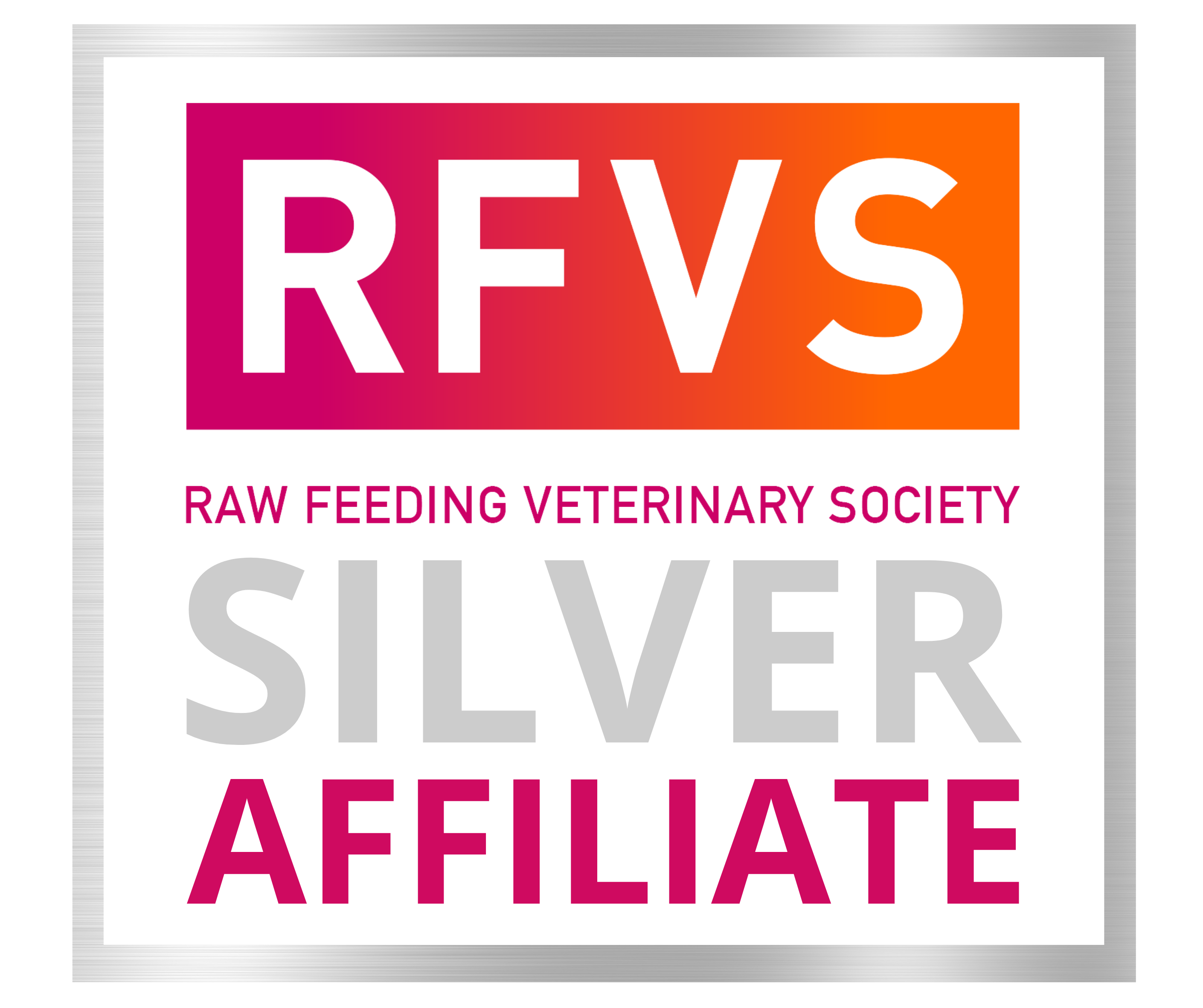Feeding Vegetables

Many people think they need to include vegetables in their pets raw diet but, we are fortunate in New Zealand that we can readily access high quality green tripe for our pets.
To some degree, dogs will scavenge and eat vegetation in the wild, so it seems likely that many dogs will be able to eat some vegetables without problems. However, figuring out which vegetables are appropriate can be challenging.
As part of a well-planned raw diet we rely on the pre-digested and fermented plant matter in green tripe, rather than adding vegetables. We recommend providing your pet with a raw diet based as closely as possible to whole prey.
WHAT IS GREEN TRIPE?
Green tripe is the unbleached, minimally washed stomach of ruminant animals like deer, cattle and sheep. The plant matter in tripe is beneficial to cats and dogs because it has been pre-digested by a herbivore. We are lucky that in New Zealand we have easy access to green tripe unlike raw feeders in some other countries with limited or no access, who then supplement the raw diet with vegetables.
BENEFITS OF FEEDING GREEN TRIPE
● Green tripe is immensely nutritious and beneficial.
● It is a natural probiotic, bursting with beneficial bacteria produced from fermented vegetable matter.
● Green tripe stimulates stomach acidity because it is high in protein and low in carbohydrates.
DO CATS AND DOGS NEED CARBOHYDRATES?
Dogs and cats must have fat and protein to survive, however they have no nutritional requirement for carbohydrates, and AAFCO makes no recommendation for their inclusion. Modern pet food tends to be high in carbohydrates, and this has the potential to be problematic, particularly in terms of fibre and obesity.
The fibre (ref 1) component of carbohydrates reduces the absorption of essential nutrients.
Obesity is an important health concern because fat cells produce inflammatory cytokines which contribute to a range of diseases. The role carbohydrates play in obesity is increasingly well understood.
Nutritional ecologist, Professor David Raubenheimer (ref 2) demonstrated that dogs, cats and humans eat to satisfy their protein requirements. By diluting the protein content of a diet with carbohydrates, the dog or cat will be driven to eat their way through the extra carbohydrate in order to get enough protein.
The structure and function of a carnivore’s digestive tract offers us clues as to what their diet should be. Carnivores have:
● Sharp teeth with a scissor-like action of the jaw, as opposed to the flat, grinding teeth of a herbivore or omnivore.
● A stretchy, acidic stomach to digest large, boney prey meals
● A short, simple digestive tract - not designed to ferment plant matter as opposed to the long digestive tract of the herbivore or omnivore
● Low levels of starch digesting enzymes, such as amylase, compared their plant eating counterparts. Some dog breeds have been shown to have more ability to digest starches than others, however that does not necessarily mean they thrive on a high starch diet.
WHAT ABOUT THE BENEFITS OF VEGETABLES?
Vegetables are a source of nutrients, but only if they are able to be digested. We believe they contribute to people's health as omnivores, however how do our carnivorous pets get the same benefits in their prey-based diet of predominantly meat, bones, organs and tripe?
Vitamins and Minerals
In addition to the readily available nutrients in meat, bone and tripe, organs such as liver and kidney are nature’s multivitamin. Organs are a vital component of a raw diet and should be provided in approximate prey proportions. Oily fish and eggs are also a powerhouse of nutrition. Wild prey are particularly nutritious, as they free-range on foliage and are naturally organic.
Fibre
For carnivores, roughage (in the form of bones, tendons and ligaments) provides the same gut-health promoting benefits as plant fibre in people.
Antioxidants
Antioxidants are important to help fight oxidative damage in the body. A well-planned raw diet provides antioxidants such as Vitamin E, Selenium and Coenzyme Q10, along with good levels of unoxidised dietary fat to aid the absorption of Vitamin E and other fat soluble vitamins.
Reducing exposure to pesticides, chemicals, additives, preservatives and inappropriate foods will help reduce oxidative stress in your pet.
Dogs and cats produce their own Vitamin C. Selenium is abundant in meat, fish and eggs. Heart is an excellent source of coenzyme Q10.
Provision of species-appropriate nutrients is important. The beta-carotene in brightly coloured vegetables is readily converted to vitamin A in herbivores, but omnivores, and in particular carnivores, are much less efficient at this process. Vitamin A is abundant in liver.
This study examined the effect on microbial diversity and digestibility of a meat-only diet compared to a kibble diet. A meat-only diet is nutritionally incomplete. A more accurate reflection of a healthy carnivore’s microbiome would be achieved by a prey-based raw diet including roughage such as bone, cartilage and tripe. This review highlights that there is yet much to be learnt about the microbiome of a carnivore.
CAN I FEED VEGETABLES?
Though it is hard to be definitive, it is possible that some pets may benefit from the addition of vegetables. If you choose to add vegetables to the diet:
1. Avoid
● starchy vegetables (such as kumara, potato, chickpeas, pumpkin), and fruit, as they might interfere with digestion and nutrient absorption.
● potentially toxic fruit and vegetables such as onions, avocado, grapes/raisins, rhubarb, garlic (small amounts may be ok - but care is needed), and brassicas (such as cabbage).
2. Monitor them closely and keep a diary of
● any digestive issues, such as wind, belching, loose/difficult stools, loud gurgly tummy, obsessive grass eating, vomiting, bloating etc
● changes in their general health, including energy levels, coat and body condition, demeanour.
3. Consider Zoopharmacognosy, where you allow your pet to choose whether they eat the plant matter, rather than trying to hide it in their meal.
4. Blend, cook or ferment plant matter before feeding, to make the nutrients more available, as they would be from their herbivorous prey’s gut.
Please let our staff know if you decide to add anything extra to your dog or cat's diet.
WHY NOT ADD VEGETABLES?
Stomach acidity Plant matter is high in carbohydrate and therefore can negatively impact stomach acidity. The importance of good stomach acidity is discussed in this article. Poor stomach acidity impedes protein digestion and raises the risk of food-bourne illness. (ref 3, ref 4, ref 5, ref 6, ref 7)
Anti-nutrients
There isn’t a great deal of data on the effects of anti-nutrients on cats and dogs. In the absence of safety studies, and on the basis of the available evidence from human studies, we recommend against feeding vegetables to cats, and exercising caution if feeding them to dogs.
This article discusses anti-nutrients in humans. Examples include;
● Oxalates (found in leafy greens) can interfere with calcium absorption
● Phytates (ref 11) (found in legumes, seeds, grains and nuts) can affect the assimilation of iron, zinc, magnesium and calcium.
● Lectins (ref 10) (found in legumes and grains) can interfere with the absorption of calcium, iron, phosphorus, and zinc.
● Brassicas such as cabbage, kale & broccoli may influence thyroid metabolism - Glucosinolates in brassicas (ref 8, ref 9) can also prevent iodine absorption.
● Blueberries and red cabbage contain antithiamine factors, referenced in this paper.
Grains
Gluten/Oats/Fibre - this study (ref 13) shows that high childhood intakes correlate with the development of autoimmune disease. There are so many other studies about the negative impacts of gluten and grains that we recommend absolutely avoiding them.
Canine Dilated Cardiomyopathy
Canine Dilated Cardiomyopathy (ref 12) is a heart condition in dogs that is sometimes linked with nutrition. We still have a lot to learn on this issue, but it seems to be pretty well accepted that it is related to the vegetable content of grain-free diets. It is not a disease associated with a well-planned raw diet.
INDIVIDUAL PETS
Ultimately, a good species-appropriate diet should be tailored to suit your individual pet, including digestion, health and preferences.
For more information:
● Read our article on fibre requirements for cats and dogs.
● Dr Zoran Jankovic, a member of the UK Raw Feeding Veterinary Society discusses raw feeding and vegetables further in his blog.
References:
1: Linda P. Case, Leighann Daristotle, Michael G. Hayek, Melody Foess Raasch, Chapter 12 - Protein Requirements, Canine and Feline Nutrition (Third Edition), Mosby, 2011, Pages 89-106,(https://www.sciencedirect.com/science/article/pii/B978032306619810012X)
2: Chandler M, Cunningham S, Lund EM, Khanna C, Naramore R, Patel A, Day MJ. Obesity and Associated Comorbidities in People and Companion Animals: A One Health Perspective. J Comp Pathol. 2017 May;156(4):296-309. doi: 10.1016/j.jcpa.2017.03.006. Epub 2017 Apr 28. PMID: 28460795.
3: Saint-Hilaire, S.,Lavers, M.K., Kennedy, J. & Code, C.F. (1960). Gastric acid secretory value of different foods. Gastroenterology,
4: Lennard-Jones, J.E., Fletcher, J. & Shaw, D.G. (1968). Effect of different foods on the acidity of the gastric contents in patients with duodenal ulcer. Gut (BMJ), 9, 177-182.
5: Lichtenberger, L.M. (1982). Importance of food in the regulation of gastrin release and formation. American Journal of Physiology 243, G429-441.
6: Brooks, F.P. (1985). Effect of diet on gastric secretion. American Journal of Clinical Nutrition, 42, 1006-1019.
7: DelValle, J. & Yamada, T. (1990). Amino acids and amines stimulate gastrin release from canine antral G-cells via different pathways. Journal of Clinical Investigation, 85, 139-143
8: Alexander, J., Auðunsson, G.A., Benford, D. et al (2008). Glucosinolates as undesirable substances in animal feed. European Food Safety Authority Journal, 590, 1-76. doi:https://doi.org/10.2903/j.efsa...
9: Tripathi, M.K. & Mishra, Awadhesh. (2007). Glucosinolates in animal nutrition: A review. Animal Feed Science and Technology - ANIM FEED SCI TECH. 132. 1-27. 10.1016/j.anifeedsci.2006.03.003.
10: Harvard T.H. Chan School of Public Health, Lectins, https://www.hsph.harvard.edu/n...
11: Pereira AM, Guedes M, Matos E, Pinto E, Almeida AA, Segundo MA, Correia A, Vilanova M, Fonseca AJM, Cabrita ARJ. Effect of Zinc Source and Exogenous Enzymes Supplementation on Zinc Status in Dogs Fed High Phytate Diets. Animals (Basel). 2020 Feb 29;10(3):400. doi: 10.3390/ani10030400. PMID: 32121315; PMCID: PMC7142709.
12: Smith, C.E., Parnell, L.D., Lai, CQ. et al. Investigation of diets associated with dilated cardiomyopathy in dogs using foodomics analysis. Sci Rep 11, 15881 (2021). https://doi.org/10.1038/s41598...
13: Depauw S, Hesta M, Whitehouse-Tedd K, Vanhaecke L, Verbrugghe A, Janssens GP. Animal fibre: the forgotten nutrient in strict carnivores? First insights in the cheetah. J Anim Physiol Anim Nutr (Berl). 2013

